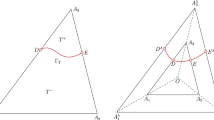Abstract
In this paper, a new finite element and finite difference (FE-FD) method has been developed for anisotropic parabolic interface problems with a known moving interface using Cartesian meshes. In the spatial discretization, the standard \(P_1\) FE discretization is applied so that the part of the coefficient matrix is symmetric positive definite, while near the interface, the maximum principle preserving immersed interface discretization is applied. In the time discretization, a modified Crank-Nicolson discretization is employed so that the hybrid FE-FD is stable and second order accurate. Correction terms are needed when the interface crosses grid lines. The moving interface is represented by the zero level set of a Lipschitz continuous function. Numerical experiments presented in this paper confirm second order convergence.



Similar content being viewed by others
Notes
Some quantities in this subsection such as \(\theta ^*,\) \(\xi _k\), and \(\eta _k\), etc. depend on i and j. For simplicity of the presentation, we omit the dependence.
References
Adams, L., Li, Z.: The immersed interface/multigrid methods for interface problems. SIAM J. Sci. Comput. 24, 463–479 (2002). https://doi.org/10.1137/S1064827501389849
Bergmann, S., Albe, K., Flegel, E., Barragan-Yani, D.A., Wagner, B.: Anisotropic solid-liquid interface kinetics in silicon: an atomistically informed phase-field model. Modell. Simul. Mater. Sci. Eng. 25(6), 065015 (2017). https://doi.org/10.1088/1361-651X/aa7862
Braess, D.: Finite Elements: Theory, Fast Solvers, and Applications in Solid Mechanics, 3rd edn. Cambridge University Press, Cambridge (2007)
Brenner, S.C., Scott, L.R.: The Mathematical Theory of Finite Element Methods. Springer, New York (2002)
De Zeeuw, D.: Matrix-dependent prolongations and restrictions in a blackbox multigrid solver. J. Comput. Appl. Math. 33, 1–27 (1990). https://doi.org/10.1016/0377-0427(90)90252-U
Dong, B.Y., Feng, X.F., Li, Z.: An FE-FD method for anisotropic elliptic interface problems. SIAM J. Sci. Comput. 42, B1041–B1066 (2020). https://doi.org/10.1137/19M1291030
Dong, B.Y., Feng, X.F., Li, Z.: An L∞ second order Cartesian method for 3D anisotropic elliptic interface problems. J. Comput. Math. 40, 886–913 (2022). https://doi.org/10.4208/jcm.2103-m2020-0107
Evans, L. C.: Partial Differential Equations. AMS (1998)
He, X., Lin, T., Lin, Y., Zhang, X.: Immersed finite element methods for parabolic equations with moving interface. Numer. Methods Partial Differential Equations 29(2), 619–646 (2013). https://doi.org/10.1002/num.21722
Hou, T., Li, Z., Osher, S., Zhao, H.: A hybrid method for moving interface problems with application to the Hele-Shaw flow. J. Comput. Phys. 134, 236–252 (1997). https://doi.org/10.1006/jcph.1997.5689
Huang, W., Rokhlin, S.I.: Interface waves along an anisotropic imperfect interface between anisotropic solids. J. Nondestruc. Eval. 11, 185–198 (1992). https://doi.org/10.1007/BF00566409
Langer, J.S.: Instabilities and patten formation in crystal growth. Rev. Modern Phys. 52, 1–28 (1980). https://doi.org/10.1103/RevModPhys.52.1
Levitas, V.I., Warren, J.A.: Phase field approach with anisotropic interface energy and interface stresses: large strain formulation. J. Mech. Phy. Solids. 91, 94–125 (2016). https://doi.org/10.1016/j.jmps.2016.02.029
Li, Z.: Immersed interface method for moving interface problems. Numer. Algorithm 14, 269–293 (1997). https://doi.org/10.1023/A:1019173215885
Li, Z., Ito, K.: Maximum principle preserving schemes for interface problems with discontinuous coefficients. SIAM J. Sci. Comput. 23, 1225–1242 (2001). https://doi.org/10.1137/S1064827500370160
Li, Z., Soni, B.: Fast and accurate numerical approaches for Stefan problems and crystal growth. Numer. Heat Transf. B: Fundam. 35, 461–484 (1999). https://doi.org/10.1080/104077999275848
Lin, T., Lin, Y., Zhang, X.: A method of lines based on immersed finite elements for parabolic moving interface problems. Adv. Appl. Math. Mech. 5(4), 548–568 (2013). https://doi.org/10.1017/S2070073300001387
Lin, T., Lin, Y., Zhang, X.: Immersed finite element method of lines for moving interface problems with nonhomogeneous flux jump. Contemp. Math. 586, 257–265 (2013). https://doi.org/10.1090/conm/586/11633
McFadden, G.B., Wheeler, A.A., Braun, R.J., Coriell, S.R., Sekerka, R.F.: Phase-field models for anisotropic interfaces. Phys. Rev. E 48, 2016–2024 (1993). https://doi.org/10.1103/PhysRevE.48.2016
Morton, K.W., Mayers, D.F.: Numerical Solution of Partial Differential Equations. Cambridge Press, Cambridge (1995)
Sethian, J., Straint, J.: Crystal growth and dendritic solidification. J. Comput. Phys. 98, 231–253 (1992). https://doi.org/10.1016/0021-9991(92)90140-T
Schittkowski, K.: QL-quadratic Programming, version 1.5 (1991). https://www.uni-bayreuth.de/departments/math/~kschittkowski/ql.htm
Suo, Z.: Singularities, interfaces and cracks in dissimilar anisotropic media. Proc. R. Soc. A 427, 331–358 (1990)
Tuncel, N. G., Serbest, A. H.: Reflection and refraction by an anisotropic metamaterial slab with diagonal anisotropy. In: 2015 IEEE International Conference on Microwaves, Communications, Antennas and Electronic Systems (COMCAS), Tel Aviv, Israel, 2015, pp. 1–4. IEEE (2015)
Yang, Q., Zhang, X.: Discontinuous Galerkin immersed finite element methods for parabolic interface problems. J. Comput. Appl. Math. 299, 127–139 (2016). https://doi.org/10.1016/j.cam.2015.11.020
Acknowledgements
B. Dong is partially supported by the National Natural Science Foundation of China (Grant No. 12261070) and the Ningxia Key Research and Development Project of China (Grant No. 2022BSB03048). Z. Li is partially supported by the Simons (Grant No. 633724) and by Fundación Séneca grant 21760/IV/22. J. Ruiz is partially supported by the Spanish national research project PID2019-108336GB-I00 and by Fundación Séneca grant 21728/EE/22. (Este trabajo es resultado de las estancias (21760/IV/22) y (21728/EE/22) financiadas por la Fundación Séneca-Agencia de Ciencia y Tecnología de la Región de Murcia con cargo al Programa Regional de Movilidad, Colaboración Internacional e Intercambio de Conocimiento “Jiménez de la Espada”. (Plan de Actuación 2022)). We also would like to thank the referees for helpful suggestions.
Author information
Authors and Affiliations
Corresponding author
Ethics declarations
Conflict of Interest
On behalf of all authors, the corresponding author states that there is no conflict of interest.
Additional information
On the occasion of Dr. Stanley Osher’s 80th birthday.
Rights and permissions
Springer Nature or its licensor (e.g. a society or other partner) holds exclusive rights to this article under a publishing agreement with the author(s) or other rightsholder(s); author self-archiving of the accepted manuscript version of this article is solely governed by the terms of such publishing agreement and applicable law.
About this article
Cite this article
Dong, B., Li, Z. & Ruiz-Álvarez, J. A Stable FE-FD Method for Anisotropic Parabolic PDEs with Moving Interfaces. Commun. Appl. Math. Comput. 6, 992–1012 (2024). https://doi.org/10.1007/s42967-023-00281-x
Received:
Revised:
Accepted:
Published:
Issue Date:
DOI: https://doi.org/10.1007/s42967-023-00281-x
Keywords
- Anisotropic parabolic interface problem
- Hybrid finite element and finite difference (FE-FD) discretization
- Modified Crank-Nicolson scheme




